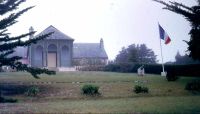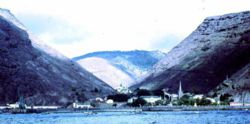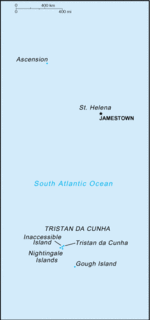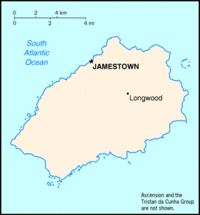Saint Helena
2007 Schools Wikipedia Selection. Related subjects: African Countries; Countries
|
|||||
| Motto: Loyal and Unshakeable | |||||
| Anthem: God Save the Queen My Saint Helena Island (unofficial) |
|||||
 |
|||||
| Capital | Jamestown | ||||
| Status | British Overseas Territory | ||||
| Official language(s) | English | ||||
| Governor | Michael Clancy | ||||
| Area | 410 km² (all islands) | ||||
| Population •2005 estimate •Density |
4,918 18/km² |
||||
| Currency | Saint Helenian pound (SHP) at parity with the UK Pound Sterling (GBP) | ||||
| Time zone | UTC +0 | ||||
| Internet TLD | .sh | ||||
| Calling Code | 290 | ||||
Saint Helena is an island of volcanic origin and an overseas territory of the United Kingdom in the South Atlantic Ocean. The territory consists of the island of Saint Helena, as well as the dependencies of Ascension Island and Tristan da Cunha.
Saint Helena is famous for being the place of exile of Napoleon Bonaparte between 1815 and his death in 1821. Longwood House, where Napoleon stayed, and Sane Valley, where he was buried, are owned by the French government, since the British government gave them to the French, in 1858.
Saint Helena is a member of the International Island Games Association.
History
The island was discovered on 21 May 1502 by the Portuguese navigator João da Nova and named after Helena of Constantinople. The Portuguese found it uninhabited, and over time built a chapel and some houses, although no permanent settlement was founded. The Portuguese introduced goats as a source of meat for future ship crews.
Thomas Cavendish became the first Englishman to visit the island, on his ill-fated expedition of 1591.
From about 1600 the island was well-known by captains from Portugal, England, France and Holland. The island was used for collecting food and as a rendez-vous point but at homebound voyages from Asia only. Sometimes ships waited near the island, when their captains were hoping to pirate hostile richly-loaded ships.
The Dutch claimed the island between 1645 and 1659, when it was settled by the English East India Company under a charter granted by Richard Cromwell.
The Dutch retook the Island in 1673, but were ejected by the English Navy after two months occupation, and the island was re-granted to the East India Company by Charles II. The English East India Company used the Island as a stop off on the long voyage to India via the Cape of Good Hope. A permanent settlement - of British colonists and black slaves - was founded at Jamestown, named after James, Duke of York (later King James II).
In 1815 the British government selected Saint Helena as the place of detention of Napoleon Bonaparte. He was brought to the island in October of that year and lodged at The Briars, outside Jamestown. In December he was moved to Longwood where he died in May 1821. During this period the island was strongly garrisoned by regular troops, and the governor, Sir Hudson Lowe, was nominated by the Crown. The British also took control of Ascension Island and Tristan da Cunha at this time, to prevent any French attempts to free Napoleon from being launched from these nearby territories. After Napoleon's death the East India Company resumed full control of Saint Helena until April 22 1834, on which date it was, in virtue of an act passed in 1833, vested in the British Crown. Napoleon's body was returned to France in 1840.
During the Second Boer War (1899-1902), the British military, fearing that Boer prisoners of war might be freed by sympathizers in South Africa, detained around 5,000 POWs on the island.
As a port of call on the long route to the Cape Colonies and India, the Island enjoyed an increased prosperity, until the construction of the Suez Canal reduced the need for long voyages via the Cape of Good Hope. During World War II, Ascension Island was leased to the United States, where a large airbase was constructed.
After World War II, the prosperity of the Island and its dependencies decreased. A visit by the Duke of Edinburgh to Ascension, Saint Helena and Tristan da Cunha for a time raised the profile of the islands. A volcanic eruption on Tristan da Cunha in 1961 forced the evacuation of the entire population to the UK, although they were able to return in 1963.
In more recent times, the British Government has announced plans to construct an airport on Saint Helena to bolster the Island's economy, and reduce the dependence on boats to supply the Island.
Demographics
Saint Helena has a small population of several thousand inhabitants, mainly descended from people from the British Isles, Scandinavia and Western and Southern Africa. In recent decades, many have migrated to the Falkland Islands or to the United Kingdom. According to the statistics in the 2005 Yearbook of Jehovah's Witnesses, Saint Helena has the largest proportion of members of that religious organization of any country or territory in the world; one person in twenty-nine is a Jehovah's Witness (roughly equaling a total of 250 people).
Tristan da Cunha has a population of about 300 inhabitants of mainly British descent. Christianity is the main religion, with the largest denominations being Anglican and Roman Catholic.
Ascension Island has no native inhabitants officially. A transient population of approximately 3,000 live on the Island, made up mainly of members of the American and British militaries, supporting civilian contractors who serve on the joint Anglo-American airbase, and members of their families (a few of whom were born on the island).
The citizens of Saint Helena and its Dependencies hold British Overseas Territories citizenship. On 21 May 2002 they were granted access to full British citizenship by the British Overseas Territories Act 2002. Also see British nationality law.
Economy
The island had a monocrop economy until 1966, based on the cultivation and processing of New Zealand flax for rope and string. St Helena's economy is now very weak, and the island is almost entirely sustained by aid from London.
The Saint Helena tourist industry is heavily based around the promotion of Napoleon's imprisonment. A golf course also exists and the possibility for sportfishing tourism is great.
Saint Helena also produces what is said to be the most expensive coffee in the world.
Ascension Island, Tristan da Cunha and Saint Helena all issue their own postage stamps which provide a significant income.
The Saint Helenian pound is the local currency, and is on a par with the Pound Sterling. The government of Saint Helena produces its own coinage and banknotes.
The territory has its own bank, the Bank of St. Helena which has two branches in Jamestown on Saint Helena, and Georgetown, Ascension Island.
Geography
Saint Helena has a total area of 410 km², and consists of three island groups: Saint Helena itself, Ascension Island and Tristan da Cunha. Each Island group has its own distinct geography.
Saint Helena has a rugged, volcanic terrain. There are several rocks and islets off the coast, including: Castle Rock, Speery Island, The Needle, Lower Black Rock, Upper Black Rock (South), Bird Island (Southwest), Black Rock, Thompson's Valley Island, Peaked Island, Egg Island, Lady's Chair, Lighter Rock (West), Long Ledge (Northwest), Shore Island, George Island, Rough Rock Island, Flat Rock (East), The Buoys, Sandy Bay Island, The Chimney, White Bird Island and Frightus Rock (Southeast), all of which are within one kilometre of the shore. The centre of Saint Helena is covered by forest, of which some have been planted, including the new Millenium Forest Project. The temperature is also 2-3 degrees cooler in the highlands, and it has a few inches a year more rainfall than the rest of the island. It is more tropical in nature, and contains most of the island's endemic flora, fauna, insects and birds. The coastal areas are barren, covered in volcanic rock and are warmer and drier than the centre of the island.
When the island was discovered it was covered with unique (indigenous) vegetation, including the remarkable cabbage tree species of St Helena. The flora of St Helena contains a high proportion of endemic species, i.e. those found nowhere else. The island's interior must have been a dense subtropical forest but the coastal areas were probably quite green as well. The modern landscape is very different, with a lot of naked rock in the lower areas, and a high interior that is green - but mainly of imported vegetation. The dramatic change in landscape must be attributed to the introduction of goats and the introduction of new vegetation. As a result, the string tree ( Acalypha rubrinervis) and the St Helena olive ( Nesiota elliptica) are now extinct, and many of the other endemic plants are threatened with extinction.
Ascension Island includes the main island and several uninhabited tiny satellite islands and rocks such as Boatswain Bird Island, Boatswain Bird Rock (East), White Rocks (South), and Tartar Rock. The main island has an area of approximately 35 square miles and is formed by volcanic peak rising from just west of the mid-Atlantic Ridge known as Green Mountain. Most of the island is a moonscape of rugged black lava flows and red windwhipped cinder cones. Where lava has penetrated to the ocean a striking seashore is dotted with white sand. The climate is subtropical, with temperatures at the coast ranging from about 68 to 88 degrees Fahrenheit (20 - 31 Celsius).
Tristan da Cunha includes the main Tristan da Cunha Island, the world's most remote inhabited island and several other uninhabited islands: Gough Island, Inaccessible Island, and the three Nightingale Islands. The islands are all mountainous and volcanic. Queen Mary's Peak on Tristan da Cunha at 2,060 m is the highest peak.
Saint Helena is one of the most isolated places in the world, located more than 2000km (nearly 1,000 miles) from the nearest major landmass. As there is currently has no airport on Saint Helena, travel to the island is by ship only. The RMS Saint Helena berths in James Bay approximately 30 times per year. The ship calls on such other ports as Capetown, Ascension Island, Tenerife, Vigo, and Walvis Bay.
Administrative divisions
Administratively, the territory is divided into three areas:
| Group | Area | Population | Capital |
|---|---|---|---|
| Saint Helena (administrative area) | 122 | 5157 | Jamestown |
| Ascension (dependency) | 88 | 1122 | Georgetown |
| Tristan da Cunha (dependency) | 200 | 284 | Edinburgh of the Seven Seas |
| SAINT HELENA Overseas Territory |
410 | 6563 | Jamestown |
Saint Helena is also divided into the following districts:
| District | Area (km2) | Population 1998 |
|---|---|---|
| Alarm Forest | 5.9 | 279 |
| Blue Hill | 36.5 | 175 |
| Half Tree Hollow | 1.6 | 1126 |
| Jamestown | 3.6 | 864 |
| Levelwood | 14.0 | 373 |
| Longwood | 33.4 | 951 |
| Sandy Bay | 15.3 | 254 |
| Saint Paul's | 11.4 | 893 |
| SAINT HELENA (Island) | 121.7 | 4915 |
Politics
Executive authority in Saint Helena is invested in Queen Elizabeth II and is exercised on her behalf by the Governor of Saint Helena. The Governor is appointed by the Queen on the advice of the British Government. Defence and Foreign Affairs remain the responsibility of the United Kingdom.
There are 15 seats in the Legislative Council, a unicameral legislature. 12 of the 15 members are elected in elections held every four years. The other three members are the Governor and two ex officio officers. The Executive Council consists of the Governor, two ex officio officers, and six elected members of the Legislative Council appointed by the Governor. There is no elected Chief Minister, and the Governor acts as the head of government. The current Governor is Michael Clancy (since October 2004).
Both Ascension Island and Tristan da Cunha have an Administrator appointed to represent the Governor of Saint Helena.
Transport
Saint Helena and its dependencies are among some of the most remote islands in the world. Although a large airfield is based in Ascension Island, with weekly flights to London, Saint Helena and Tristan da Cunha can only be reached by boat. The RMS Saint Helena runs between the United Kingdom, Ascension, St Helena and Cape Town. It no longer calls at Tristan da Cunha.
The British Government announced plans to construct an airport in Saint Helena in March 2005. The airport is expected to be completed by 2010.
There is also a bus, really a van, that goes around the island and down to Jamestown to pick up people from the major neighborhoods, mostly Half Tree Hollow.






